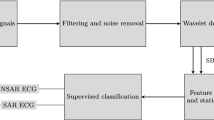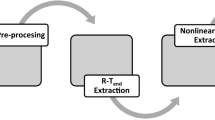Abstracts
Purpose
Ventricular fibrillation (VF) is a common cardiac arrest rhythm that can be terminated by electrical defibrillation. During cardiopulmonary resuscitation, there is a strong need for a prompt and reliable predictor of successful defibrillation because myocardial damage can result from repeated futile defibrillation attempts. Continuous wavelet transform (CWT) provides excellent time and frequency resolution of signals. The purpose of this study was to evaluate whether features based on CWT could predict successful defibrillation.
Methods
VF electrocardiogram (ECG) waveforms stored in ambulance-located defibrillators were collected. Predefibrillation waveforms were divided into 1.0- or 5.12-s VF waveforms. Indices in frequency domain or nonlinear analysis were calculated on the 5.12-s waveform. Simultaneously, CWT was performed on the 1.0-s waveform, and total low-band (1–3 Hz), mid-band (3–10 Hz), and high-band (10–32 Hz) energy were calculated.
Results
In 152 patients with out-of-hospital cardiac arrest, a total of 233 ECG predefibrillation recordings, consisting of 164 unsuccessful and 69 successful episodes, were analyzed. Indices of frequency domain analysis (peak frequency, centroid frequency, and amplitude spectral area), nonlinear analysis (approximate entropy and Hurst exponent, detrended fluctuation analysis), and CWT analysis (mid-band and high-band energy) were significantly different between unsuccessful and successful episodes (P < 0.01 for all). However, logistic regression analysis showed that centroid frequency and total mid-band energy were effective predictors (P < 0.01 for both).
Conclusions
Energy spectrum analysis based on CWT as short as a 1.0-s VF ECG waveform enables prompt and reliable prediction of successful defibrillation.




Similar content being viewed by others
References
Xie J, Weil MH, Sun S, Tang W, Sato Y, Jin X, Bisera J. High-energy defibrillation increases the severity of postresuscitation myocardial dysfunction. Circulation. 1997;96:683–8.
Yamaguchi H, Weil MH, Tang W, Kamohara T, Jin X, Bisera J. Myocardial dysfunction after electrical defibrillation. Resuscitation. 2002;54:289–96.
Sato Y, Weil MH, Sun S, Tang W, Xie J, Noc M, Bisera J. Adverse effects of interrupting precordial compression during cardiopulmonary resuscitation. Crit Care Med. 1997;25:733–6.
Wik L, Hansen TB, Fylling F, Steen T, Vaagenes P, Auestad BH, Steen PA. Delaying defibrillation to give basic cardiopulmonary resuscitation to patients with out-of-hospital ventricular fibrillation: a randomized trial. JAMA. 2003;289:1389–95.
Cobb LA, Fahrenbruch CE, Walsh TR, Copass MK, Olsufka M, Breskin M, Hallstrom AP. Influence of cardiopulmonary resuscitation prior to defibrillation in patients with out-of-hospital ventricular fibrillation. JAMA. 1999;281:1182–8.
Yu T, Weil MH, Tang W, Sun S, Klouche K, Povoas H, Bisera J. Adverse outcomes of interrupted precordial compression during automated defibrillation. Circulation. 2002;106:368–72.
Weaver WG, Cobb LA, Dennis D, Ray R, Hallstrom AP, Copass MK. Amplitude of ventricular fibrillation waveform and outcome after cardiac arrest. Ann Intern Med. 1985;102:53–5.
Brown CG, Dzwonczyk R. Signal analysis of the human electrocardiogram during ventricular fibrillation: frequency and amplitude parameters as predictors of successful countershock. Ann Emerg Med. 1996;27:184–8.
Strohmenger H-U, Lindner KH, Brown CG. Analysis of the ventricular fibrillation ECG signal amplitude and frequency parameters as predictors of countershock success in humans. Chest. 1997;111:584–9.
Stewart AJ, Allen JD, Adgey AAJ. Frequency analysis of ventricular fibrillation and resuscitation success. Q J Med. 1992;306:761–9.
Young C, Bisera J, Gehman S, Snyder D, Tang W, Weil MH. Amplitude spectrum area: measuring the probability of successful defibrillation as applied to human data. Crit Care Med. 2004;32:S356–8.
Callaway CW, Sherman LD, Mosesso VN Jr, Dietrich TJ, Holt E, Clarkson MC. Scaling exponent predicts defibrillation success for out-of-hospital ventricular fibrillation cardiac arrest. Circulation. 2001;103:1656–61.
Podbregar M, Kovacic M, Podbregar-Marsc A, Brezocnik M. Predicting defibrillation success by ‘genetic’ programming in patients with out-of-hospital cardiac arrest. Resuscitation. 2003;57:153–9.
Lin LY, Lo MT, Ko PC, Lin C, Chiang WC, Liu YB, Hu K, Lin JL, Chen WJ, Ma MH. Detrended fluctuation analysis predicts successful defibrillation for out-of-hospital ventricular fibrillation cardiac arrest. Resuscitation. 2010;81:297–301.
Eftestøl T, Sunde K, Ole Aase S, Husoy JH, Steen PA. Predicting outcome of defibrillation by spectral characterization and nonparametric classification of ventricular fibrillation in patients with out-of-hospital cardiac arrest. Circulation. 2000;102:1523–9.
Addison PS, Watson JN, Clegg GR, Holzer M, Sterz F, Robertson CE. Evaluating arrhythmias in ECG signals using wavelet transforms. Real time analysis of the ventricular fibrillation waveform can reveal hidden structures. IEEE Eng Med Biol Mag. 2000;19:104–9.
Watson JN, Uchaipichat N, Addison PS, Clegg GR, Robertson CE, Eftestøl T, Steen PA. Improved prediction of defibrillation success for out-of-hospital VF cardiac arrest using wavelet transform methods. Resuscitation. 2004;63:269–75.
Koster RW, Walker RG, van Alem AP. Definition of successful defibrillation. Crit Care Med. 2006;34:S423–6.
Pincus SM. Approximate entropy as a measure of system complexity. Proc Natl Acad Sci USA. 1991;88:2297–301.
Glenny RW, Robertson HT, Yamashiro S, Bassingthwaighte JB. Applications of fractal analysis to physiology. J Appl Physiol. 1991;70:2351–67.
Higuchi T. Approach to an irregular time series on the basis of the fractal theory. Physica D. 1988;31:277–83.
Peng CK, Havlin S, Stanley HE, Goldberger AL. Quantification of scaling exponents and crossover phenomena in nonstationary heartbeat time series. Chaos. 1995;5:82–7.
Callaway CW, Menegazzi JJ. Waveform analysis of ventricular fibrillation to predict defibrillation. Curr Opin Crit Care. 2005;11:192–9.
Watson JN, Addison PS, Clegg GR, Holzer M, Sterz F, Robertson CE. A novel wavelet transform based analysis reveals hidden structure in ventricular fibrillation. Resuscitation. 2000;43:121–7.
Eftestøl T, Sunde K, Aase SO, Husøy JH, Steen PA. Probability of successful defibrillation as a monitor during CPR in out-of-hospital cardiac arrested patients. Resuscitation. 2001;48:245–54.
Goldberger AL, Peng CK, Lipsitz LA. What is physiologic complexity and how does it change with aging and disease? Neurobiol Aging. 2002;23:23–6.
Amann A, Mayr G, Strohmenger H-U. N(α)-histogram analysis of the ventricular fibrillation ECG-signal as predictor of countershock success. Chaos Solutions Fractals. 2000;11:1205–12.
Sherman LD, Callaway CW, Menegazzi JJ. Ventricular fibrillation exhibits dynamical properties and self-similarity. Resuscitation. 2000;47:163–73.
Sherman LD, Rea TD, Waters JD, Menegazzi JJ, Callaway CW. Logarithm of the absolute correlations of the ECG waveform estimates duration of ventricular fibrillation and predicts successful defibrillation. Resuscitation. 2008;78:346–54.
Addison PS. The continuous wavelet transform. In: The illustrated wavelet transform handbook. New York: Taylor & Francis; 2002. p. 6–63.
Acknowledgments
We wish to thank EMS personnel and paramedics in Niigata City for making this study possible. This study was supported in part by Grants-in-Aid for Scientific Research from Japan Society of the Promotion of Science to H.E. (#20390458).
Author information
Authors and Affiliations
Corresponding author
Appendix
Appendix
Continuous wavelet transform (CWT)
CWT is defined as the convolution of a signal and an analyzing wavelet (ψ).
where the asterisk indicates a complex conjugate, α indicates the scale (dilation), τ indicates a time shift, and signal (t) denotes sample t in the VF waveform segment of length n. In this study, a complex Morlet wavelet was employed as the analyzing wavelet (ψ) [16, 17].
The proportional contribution to the signal energy at a specific scale and a location τ is given by the two-dimensional wavelet energy density function:
where C g is the wavelet-dependent admissibility constant that ensures conservation of energy in wavelet space [30].
Frequency-domain analysis
Fourier transform is defined as follows:
where fi indicates frequency and signal (t) denotes sample t in VF waveform segment of length n.
Power spectral density (PSD) describes how the power of a signal is distributed with frequency. Mathematically, it is defined as the squared modulus of the Fourier transform of the signals.
where fi indicates frequency and argmax indicates the fi attaining a max value of PSD.
where ASD(fi) indicates amplitude spectral density, calculated as
About this article
Cite this article
Endoh, H., Hida, S., Oohashi, S. et al. Prompt prediction of successful defibrillation from 1-s ventricular fibrillation waveform in patients with out-of-hospital sudden cardiac arrest. J Anesth 25, 34–41 (2011). https://doi.org/10.1007/s00540-010-1043-x
Received:
Accepted:
Published:
Issue Date:
DOI: https://doi.org/10.1007/s00540-010-1043-x




